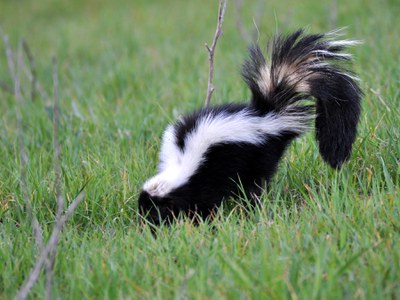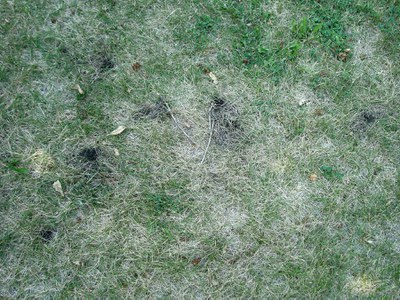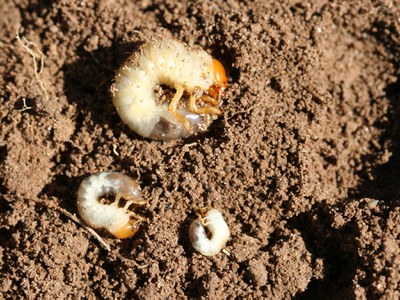Hunting for Grubs
 |
|
Skunk digging for grubs. |
 |
|
Skunks dig holes in lawns looking for grubs. Raccoons have been known to dig |
 |
|
Grubs of June beetles. |
Do you have mysterious holes appearing in your lawn? You could have hungry skunks or raccoons visiting you at night. Once they find a grub-infested lawn, they will keep coming back for more.
You can stop the damage from skunks and raccoons by taking away their food. Kill the grubs with an insecticide, and the wildlife will hunt for grubs in someone else’s yard. Outdoor lighting or rags soaked with ammonia may help to repel skunks, too.
Before treating with an insecticide, make sure grubs are in your lawn. Do the “tug test.” Grab a handful of damaged turf and tug it up. If it comes up easily, this is likely due to grubs, which gnaw on turf roots.
Peel back the damaged turf. The grubs, if present, will be right near the surface. They will curl into a C-shape and be the length of about 0.5 to 1.0 inch.
It's common for grubs to be in a lawn. Three or more grubs per square foot near the soil surface are needed to warrant any chemical treatment.
Don't treat if you do not see the grubs. You are wasting your money on killing a pest that is not there. You may also be introducing an insecticide to the environment that is harmful to bees and other beneficial insects.
Among grub-killing chemicals, triclorfon and carbaryl act within days. These "curative" chemicals are applied when grub populations are severe and will persist only during the particular season they are applied (usually late spring or fall).
Imidacloprid and chlorantraniliprole are applied as a preventative in early summer to kill grubs in late summer and fall when many severe grub problems occur. They should not be applied now.
Make sure you mow your lawn before applying the insecticide. This will remove any weed flowers and protect bees from being harmed. Imadicloprid and carbaryl are particularly toxic to bees; chlorantraniliprole is not toxic to bees.
If you apply an insecticide, irrigate the chemical deeply to move it down to the grubs. Apply at least 0.5 inches of water as soon as possible after application.
The vast majority of lawns do not have harmful populations of grubs. A vigorous and healthy lawn can tolerate some grubs.
Milky disease spore (Bacillus popilliae) products are not effective at controlling grub species in our state.
Grub problems will begin to decline when the grubs start burrowing deeper to escape the winter cold. When the grubs go away, so will the skunks and raccoons.
Written by Tom Kalb, Extension Horticulturist. North Dakota State University. Photos courtesy of g.h.vandoorn; Irene Graves; Steven Katovich, Bugwood.org. Contributing source: Smitley, D., T. Davis and E. Hotchkiss. 2020. How to choose and when to apply grub control products for your lawn. Michigan State University.





